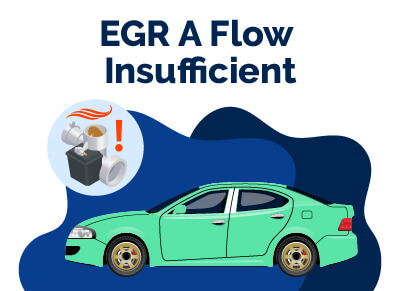EGR a Flow Insufficient Detected (P0401): Causes and Fixes
July 23, 2023


Chris is Head of Content for FindTheBestCarPrice and is based out of Philadelphia, PA. As a seasoned automotive industry analyst and car enthusiast, he ensures the highest level of quality across all our content and curates our picks for the best deals each month.
Chris studied information systems and marketing at Drexel University and writes about a wide range of topics ranging from car buying tips to troubleshooting common mechanical issues.
When he’s not thinking about cars, he likes to stay in with his dog and make an “attempt” to finish a crossword puzzle (he’s not quite at the Saturday/Sunday level…yet). As a former cheesemonger, Chris still has a “sharp” passion for all things cheese, and his fridge is always loaded with it!
Chris also has a passion for things that go fast, and drones are no exception. He spends some of his time writing for Dronesourced.
Exhaust Gas Recirculation (EGR), a flow insufficient detected, is a diagnostic trouble code indicating a problem with a vehicle's EGR system.
The EGR system reduces harmful emissions by recirculating a portion of the engine's exhaust gasses back into the combustion chamber.
If the EGR valve, sensor, or system is not functioning correctly, the computer will detect a reduction in exhaust gas flow and trigger the P0401 code.
This code can decrease vehicle performance, increase emissions, and lead to other engine problems if addressed. Troubleshooting and repairing the EGR system can typically resolve this issue.
Let’s discuss the meaning of EGR, a flow insufficient detected (P0401), the causes of it, how to tackle it, etc.
Table of Contents
- What Is P0401?
- Major Causes of EGR Malfunction
- EGR a Flow Insufficient Detected (Common Symptoms)
- How To Diagnose a P0401 Code
- Common Mistakes When Diagnosing a P0401 Code
- How To Fix a P0401 Code
- How Much Does Fix, Repair, or Diagnose P0401 Code Cost?
- Potential Repair Costs for P0401
- Best Car Deals by Category
- Frequently Asked Questions
What Is P0401?
The P0401 fault code signifies a deficiency in Exhaust Gas Recirculation (EGR) flow as detected by the Engine Control Module (ECM) in a vehicle.
As a vehicle's cylinder temperature rises to an extremely high level, nitrogen oxide (NOx emissions) harmful to the environment are produced. The EGR system is designed to regulate these NOx emissions by redirecting the EGR gas back into the engine for combustion.
The EGR system comprises three critical components: an EGR valve, an EGR solenoid, and a DPFE sensor (Differential Pressure Feedback Electronic), which work together to ensure that the engine control module receives the specified amount of recirculated EGR gas.
However, a malfunctioning EGR valve, EGR solenoid, or DPFE sensor could result in an EGR flow malfunction, leading to the DTC P0401 and illumination of the Check Engine Light on the vehicle dashboard.
Major Causes of EGR Malfunction
Although the P0401 error code may not be a conclusive indicator of the precise cause of an EGR malfunction, it can provide a starting point for troubleshooting and resolving the issue.
This type of malfunction can stem from a plethora of factors, such as:
- A DPFE sensor that is deteriorating
- Obstructed or congested EGR tubes
- A catalytic converter that is clogged
- The accumulation of carbon on the EGR temperature sensor
- A faulty or insufficient vacuum supply to the EGR system
- Electrical complications with the EGR circuit
- Issues with the engine's computer system.
EGR a Flow Insufficient Detected (Common Symptoms)
The indications associated with the P0401 fault code can exhibit considerable variability, contingent upon the degree of severity of the underlying problem. Here are some notable symptoms:
1. Overbearing Fuel Vapor Odor
The P0401 error code may arise due to a congested or contaminated EGR valve. An EGR valve that is not functioning correctly can impede the EGR flow rate, accumulating carbon residues in the exhaust manifold.
The emergence of a potent fuel vapor odor is a probable indication of these carbon deposits.
2. Spike in NOx Emissions
A malfunction within the EGR system could generate a deficit in the flow, leading to elevated levels of carbon residues and NOx emissions.
Consequently, an unusual amount of smoke emanating from your vehicle's tailpipe could indicate an underlying EGR malfunction.
3. Knocking Sound in the Engine
If you have observed your engine producing a noise characterized by a pinging or knocking sound, it could signify the presence of the P0401 error code.
In this scenario, a malfunctioning EGR valve limits the optimal amount of EGR flows into the intake manifold, which can engender an anomalous combustion temperature.
4. An Illuminated Check Engine Light
The illumination of the Check Engine Light on your dashboard can suggest a scenario of inadequate EGR flow, potentially resulting from a defective EGR valve, EGR solenoid, or DPFE sensor.
Nonetheless, given that the Check Engine Light is a prevalent manifestation of diverse engine difficulties, it is advisable to use an OBD2 scan tool to validate whether it pertains specifically to the P0401 error code.
How To Diagnose a P0401 Code
Diagnosing fault code P0401 requires specialized tools and technical expertise in the Exhaust Gas Recirculation System. A skilled mechanic would typically follow a set of procedures that involve various steps.
Initially, the mechanic would use an OBD2 scan tool to scan the engine control module for the P0401 fault code.
They would then erase existing codes and clear the Check Engine Light before test-driving the vehicle to see if the code reappears.
If the fault code or Check Engine Light persists, the mechanic would visually inspect the vacuum hose and connections to the EGR valve, including the Exhaust Gas Recirculation solenoid, MAP sensor, and EGR temperature sensor.
Subsequently, the mechanic would disconnect the EGR valve and assess whether there is an adequate vacuum supply between the valve and the EGR solenoid.
They would then remove the EGR-controlled vacuum switch valve, EGR temperature sensor, and EGR port to check for any blockages caused by excessive carbon deposits.
If there is a carbon buildup, the mechanic will use a throttle body cleaner to remove the carbon from the EGR passage, intake manifold, and vacuum hose.
Common Mistakes When Diagnosing a P0401 Code
Refrain from inspecting and purging the EGR passages while replacing a defective EGR valve.
If you don’t, it will Incorrectly ascribe a faulty status to a functional EGR valve due to excessive carbon buildup on the EGR temperature sensor, causing the failure code.
Another common mistake is failing to examine if the EGR control solenoid can maintain a vacuum before substituting the EGR valve.
How To Fix a P0401 Code
Fortunately, there are effective methods to resolve the underlying causes that can trigger a P0401 error code.
Although replacing the EGR valve is a common initial approach, it only sometimes addresses the issue. Even after the valve replacement, the error code may reappear.
To ensure that all potential causes are thoroughly addressed, the following diagnostic and maintenance steps may be helpful:
Pull the EGR valve open using a vacuum pump and monitor the engine's RPM and DPFE voltage to detect any noticeable changes while the EGR is open.
Inspect the EGR valve and tubing, and remove any deposits that may have accumulated by cleaning.
Examine the voltage at the DPFE and compare it to the standard values specified in the owner's manual.
If necessary, replace the DPFE sensor with a high-quality or OEM model.
If the issue persists, replace the EGR valve.
How Much Does Fix, Repair, or Diagnose P0401 Code Cost?
The origin of error code P0401 can vary, ranging from a clogged EGR valve, an engine vacuum leak, or a faulty EGR temperature sensor. Providing an accurate cost estimate with a proper diagnosis of the issue is more effortless.
A reputable repair shop usually begins with an hour to identify and diagnose the issue. Depending on the shop's labor rate, this diagnostic fee typically costs around $75-$150.
However, most shops will apply this cost towards any necessary repairs if you choose to have them perform them. Once diagnosed, the shop will provide an accurate repair estimate for resolving the P0401 code.
Potential Repair Costs for P0401
To rectify the underlying issue causing error code P0401, one or more of the following repairs may be necessary.
The estimated repair cost comprises the cost of the needed parts and the cost of labor required to repair.
- Exhaust Gas Recirculation (EGR) valve: $332 to $413
- Vacuum leak: $90 to $125
Best Car Deals by Category
Frequently Asked Questions
Can I still drive my car with a P0401 error code?
Driving your car with a P0401 error code is not recommended for an extended time. The issue causing the error code could cause further damage to your engine if left untreated.
How much does it cost to repair a P0401 error code?
The cost to repair a P0401 error code varies depending on the underlying issue. An EGR valve replacement can cost around $332 to $413, while fixing a vacuum leak may cost between $90 to $125.
Can I fix a P0401 error code myself?
If you have the proper knowledge and tools, it is possible to diagnose and repair a P0401 error code. However, it is not recommended for beginners as the diagnosis can be complex and requires specialized equipment.
Can a P0401 error code cause my car to fail an emissions test?
A P0401 error code indicates that your car emits more nitrogen oxides (NOx) than it should. This could cause your car to fail an emissions test.
What is an EGR valve, and what does it do?
An EGR valve is an Exhaust Gas Recirculation valve. Its primary function is to reduce the emission of nitrogen oxides (NOx) by recirculating some exhaust gases back into the engine to be burned again.
What causes a P0401 error code to appear?
A clogged EGR valve, a faulty EGR temperature sensor, an engine vacuum leak, or a malfunctioning DPFE sensor can cause a P0401 error code.
Posted in Car Buying Tips, Car Troubleshooting |




